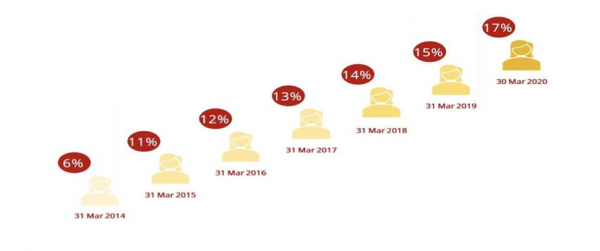 11-08-2020
11-08-2020
Praveen Gupta analyses a new study on gender diversity among Indian corporations

 Insurance Alertss
Insurance AlertssPraveen Gupta analyses a new study on gender diversity among Indian corporations
Praveen Gupta, FCII is a Chartered insurer and former CEO.
Corporate India is beginning to feel the benefits of increased gender diversity. More companies now have one woman on their boards, and several boards have more than one.
Regulations, it appears, have rejuvenated the focus on gender diversity in boardrooms, according to Corporate India: Women on Boards, a recent study undertaken by Institutional Investor Advisory Services (IIAS) in partnership with SBI Mutual Fund. While there has been a lot of progress, the country continues to trail behind global standards on including women in boardrooms.
“India remains well behind other markets that have targeted female representation of at least 30% on boards,” notes Hetal Dalal, COO of IIAS.
India versus the developed world
European countries, with female board representation between 30% and 40% continue to lead the way. In the US, women hold 20.4% of the board seats of R3000 companies in 2020. In the UK, the 30% Club achieved its stated target of a minimum of 30% women on FTSE350 boards by 2020. Initially investors, and more recently investment bankers, are driving board diversity.
India needs to catch up. The NIFTY 500 companies had 17% female representation on boards as of 30 March 2020. In India, it is regulatory changes that continue to drive the dialogue on gender diversity. Recent regulatory changes made it mandatory to have at least one female independent director on boards, effective from 1 April 2019.
While at the board level gender diversity is improving, one of the challenges that India, like many other markets face, is gender diversity at the leadership and middle-management levels. This is a critical fix that corporate India needs to address. It is only then that gender diversity at the board level will become a natural outcome.
Share of directorships held by women in NIFTY 500 companies

Source: IIAS research, PRIME Database group
Effects of the regulatory push
- NIFTY 500 companies had 17% female directors (777) out of the total 4,657 directors as of 30 March 2020.
- Multinational companies in India have a higher female representation at 19%. Public sector entities trail behind, with 11% female representation.
- Of the 777 directorships held by women on various boards, 71% are independent directors (548).
- The majority of the women being appointed to leadership roles have professional experience and expertise.
- Some 43% of the boards had two or more women directors (as of 30 March 2020) – up from 21% three years ago.
- Women are now getting a say on board composition and executive remuneration: 4% of the boards are chaired by women; and as of 30 March 2020, nomination and remuneration committees had the highest proportion of women at 18% (up from 13% in March 2017).
- The healthcare sector has the highest percentage of female directors at 21%. Energy, with 11%, has the lowest.
- The average tenure of females on the board is 4.8 years. For men, it is 8.7 years.
- Despite the increase in women on boards, board leadership continues to remain a challenge. Only 18 companies out of 491 NIFTY 500 companies had women as chairpersons.
The way forward
- Better-governed Indian companies have realised the importance of gender diversity and are acting in the right direction. Some 10% of the NIFTY 500 boards have three or more women on the board.
- Decisive steps regarding female representation on boards need to be outlined by a wide variety of stakeholders, such as regulators, companies and investors.
- The regulatory push continues to provide the right momentum. However, regulators must encourage investors to push for better gender diversity in companies.
- While the board-level gender diversity agenda is being addressed, the lack of women in the rung below the board will continue to pose a problem.
- Public sector entities are seriously lagging on gender diversity; this will require structural changes.
- Despite several companies proclaiming that they are equal-opportunity employers, the number of women in the workforce is still relatively low.
- The gender diversity agenda tends to be limited to the permanent workforce.
- The time is ripe to take decisive steps on gender diversity to signal a definitive message to investors.
Ironically, while India truly epitomises ‘unity in diversity’, the voice and role of women remain subdued and underrepresented. In a largely paternalistic society, a female child needs to navigate through a lifetime of challenges. Breaking through a glass ceiling is never easy.
While the regulators can impose quotas for the very top roles, much remains to be done to do away with the systemic barriers on the way up the hierarchy. Having said that, the study is an excellent attempt at championing fair and equitable opportunities for women in corporate India.
Source: The Journal
